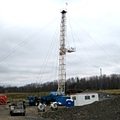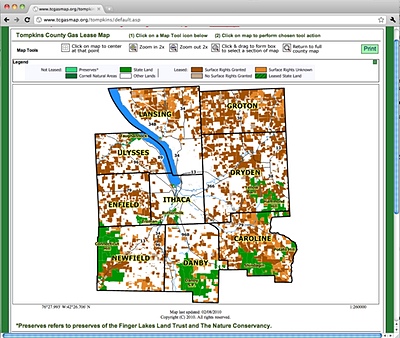- By Dan Veaner
- News
 Print
Print  Over 100 people gathered at the Lansing Middle School Auditorium Wednesday for a presentation on hydraulic fracturing (hydrofracking, or simply fracking). With so much rumor and emotion injected into the fracking issue in Tompkins County, the purpose of the presentation is to present known facts, putting them together to form a realistic picture of what the real impact of drilling could be in Tompkins County. Their task force took the information and superimposed it onto maps to present the information visually, mixing what could be with the familiar landscape here.
Over 100 people gathered at the Lansing Middle School Auditorium Wednesday for a presentation on hydraulic fracturing (hydrofracking, or simply fracking). With so much rumor and emotion injected into the fracking issue in Tompkins County, the purpose of the presentation is to present known facts, putting them together to form a realistic picture of what the real impact of drilling could be in Tompkins County. Their task force took the information and superimposed it onto maps to present the information visually, mixing what could be with the familiar landscape here.The session was presented by two members of the Tompkins County Council Of Governments (TCCOG) Task Force on Gas Drilling, Tompkins County Planner Darby Kiley and task force member Art Pearce. They have been taking their show on the road, visiting towns across the county with estimates based on facts gathered from drilling sites in Pennsylvania extrapolated and superimposed on maps of Tompkins County. They tailor their presentation to each township, showing maps of leased land, and estimating the number of potential wells and their impact based on that and New York State regulations (current and proposed).
Kiley started by explaining what is involved in hydrofraking, which includes much more than just the wells. She showed pictures of drilling sites with access roads, containment pools for water impoundment, from which the water is piped to the well head. Gas processing plants, pressure stations, and the containment pools service multiple wells, connected by gathering lines and ultimately to a pipeline. Kiley estimated that just one access road displaces nearly an acre of land.
Those estimates may be the most extreme impact -- it is based on how many multiple-well drilling pads can fit into the two Townships, based on the amount of land needed for a pad and available spaces that can accomodate pads without violating regulations on how close to streams, (water) wells, and water sources drilling pads can be, for instance.
"Close to 500 (multiple drill) well pads could be placed in Tompkins County if this were just one uniform area with no roads, no water, no people," Kiley said.
The task force attempted to guess how many pads could be located in Lansing and Groton. Their best guess was one in southern Lansing, and 29 in northern Lansing. With ten wells on each pad that could mean as many as 300 wells in the Town of Lansing. 44 pads, or 440 wells fit into allowed spaces in Groton. With space for 12 pads in Danby, 36 in Caroline, 44 in Dryden, 17 in Enfield, 3 in the Town of Ithaca, 10 in Newfield, and 14 in Ulysses, Tompkins County could potentially have as many as 2,100 wells.
 Kiley and Pearce shared a number of Internet resources, including tcgasmap.org, which has mapped current gas drilling leases to show what drilling could look like in Tompkins County.
Kiley and Pearce shared a number of Internet resources, including tcgasmap.org, which has mapped current gas drilling leases to show what drilling could look like in Tompkins County.The Marcellus Shale is very thick in Pennsylvania. Thick and deep are good for drilling -- thick because it yields more gas, and deep because regulations allow drilling farther from the surface. That may mean that Lansing will see little or no drilling at all.
"The shale is not as thick here," Kiley said. "It's also not as deep here. For those two reasons it might be less likely to be drilled in this area. DEC (the New York Department of Environmental Conservation) has regulations on how deep the shale must be in order for drilling to be permitted, and that's part of why Lansing and the northern part of Tompkins County may not be as heavily impacted."
One attendee pointed out that while drilling in Lansing may be unlikely as the Marcellus Shale is tapped, the Utica Shale makes drilling here much more likely. And even if there is no actually drilling in the town the impact on Lansing could still be great depending on where drilling actually does occur. The task force estimates that hydrofracking could generate 504,000 heavy truck trips per year. Currently there are are 600,000 one-way heavy truck trips in Tompkins County. So hydrofracking would almost double heavy traffic along roads like Ridge Road, East Shore Drive, and Auburn Road (NYS Routes 34 and 34B) main thoroughfares in Lansing. These roads are already highly travelled by heavy trucks, and the added traffic would double the wear and tear on the roads, as well as slowing down traffic, affecting the quality of life for residents.
Of course the chemicals used in hydrofracking are an issue that has many local residents up in arms, with toxic chemicals being pumped into the landscape, and companies not disclosing what they are, claiming they are proprietary business secrets. That would put a strain on the three local water treatment plants, including the Cayuga Heights plant that processes sewage for the Village and Town of Lansing. And billions of gallons of local water would be used. That would have a mixed impact. Pearce said that drilling companies might contract with Bolton Point to buy the water they need, a boon for the water commission. But there is a down side to what happens to the water in the process and where it goes afterward.
"It went down bad and it came back worse," he said. "When it goes down 4,000 to 5,000 feet under the ground it picks up heavy metals and chemicals and even radiation that is just as well left down there."
Pearce said that not all the impacts would be bad.
"Jobs are potentially one of the bright spots in all this," he said. "There have been a couple of studies in Pennsylvania that suggest that any given well can involve hundreds of people. Over 400 people could be working at any given well, but many of them over a few hours or a few days or weeks. It averages to the equivalent of about 12 full time positions per well."
Pearce said that a bright spot in the prospect of gas drilling is jobs. At least for the time they are here the drilling companies would generate the equivalent of 12 full time jobs per well. That is broken up into many part time jobs, and many of those go to out of state workers who have expertise in drilling. But some of those jobs would go to local workers, and in Tompkins County the task force estimates it could bring the equivalent of 25,200 full time jobs. That equals about 4% of the current Tompkins County workforce.
However he noted an influx of workers from other locations brings other impacts. There could be competition for the most desirable housing in Lansing as drilling executives locate here. Trailer camps and what Kiley called 'man camps' that are set up for employees when there isn't enough traditional housing for the influx of workers would likely sprout up. These workers from out of state bring children, forcing localities to build new schools to accomodate them. But these schools become worthless after a decade when drilling moves to other locations.
 Art Pearce and Darby Kiley
Art Pearce and Darby KileyCollecting this information is meant to help local municipalities put regulations into place that will help manage the impacts of drilling and possibly put the burdens of maintaining and restoring the local infrastructure on the drilling companies that add stress to them. Kiley outlined a series of 'municipal tools' that can help protect local townships. Dryden, and Ulysses are putting definitions of natural gas and petroleum exploration into their zoning language and adding that it is entirely prohibited. But it is not clear that those measures would stand up in court or that the State would support them. Kiley recommended town governments look at local zoning and land use regulations, housing rules, and flood damage protection, water wellhead and aquifer protection laws.
They may need it sooner than they thought. Yesterday the New York Times reported that Govenor Andrew Cuomo will be lifting the ban on hydrofracking in New York State, excepting only the watershed that feeds New York City and one other that feeds Syracuse.
The next presentation is scheduled on July 12 in Dryden.
v7i25



